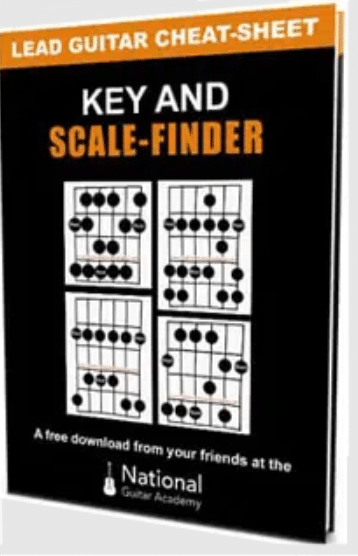F9 guitar chord is one of the coolest chords of all and is used in genres such as Funk, Jazz and Rock and Roll. In this guitar lesson we’re going to show you some of our favourite voicings of this chord.
Over 100,000 guitar-learners get our world-class guitar tips & tutorials sent straight to their inbox:
Click here to join them
Get our best guitar tips & videos
In this free lesson you will learn:
- 7 essential ways to play the F9 guitar chord.
- How to quickly master chord inversions that will make you sound amazing.
- The no1 secret that will allow you to use the F9 chord in ANY musical situation.
The F9 Guitar Chord Can Add A New Dimension To Our Chord Voicings
Often used in funk, jazz as well as ballads, the F9 guitar chord can add an air of intrigue to our playing and ‘spice up’ our chord progressions.
- This chord is bright and hopeful with an air of mystery to it. It also makes for a great transition to other chords in our guitar vocabulary.
- In this lesson, we’ll look at a variety of ways to play this chord, as well as some progressions to play it in at the end.
First, let’s break down the theory behind what we call ‘ninth chords.’

What Are ‘Ninth chords’?
Ninth chords have a warm and jazzy sound, and serve as a great transition to other minor and major chords that we already know.
This type of chord contains five notes. Let’s take a look at the chord qualities below in the key of F.
- F – Root (1)
- A – Third (Major 3rd) (3)
- C – Perfect Fifth (5)
- Eb – Minor Seventh (aka Dominant Seventh) (b7)
- G – Major Ninth (9)
Ninth chords are constructed by playing a Dominant 7th chord and adding the 2nd note of the major scale to the chord.
At this point we may wonder why we call this a ‘ninth chord’ when we are actually adding the second note of the major scale.

The most essential ways to play the F9 guitar chord involve adding the second note of the scale in the higher octave of the chord.
The Major scale contains seven notes, so we can add those seven notes to our ‘2’ in order to make ‘9’.
In essence, a 9 is just a 2 in a higher octave.
- This chord can be played a few different ways, but the easiest and most straightforward way to play it is in the first position.
- We’ll need to have some experience with barre chords in order to get one these chords under our hands.
If you need to brush up, check out our guide to playing barre chords here.

Now, let’s check out our first position.
Learn 12 EASY beginner chords with our popular guide
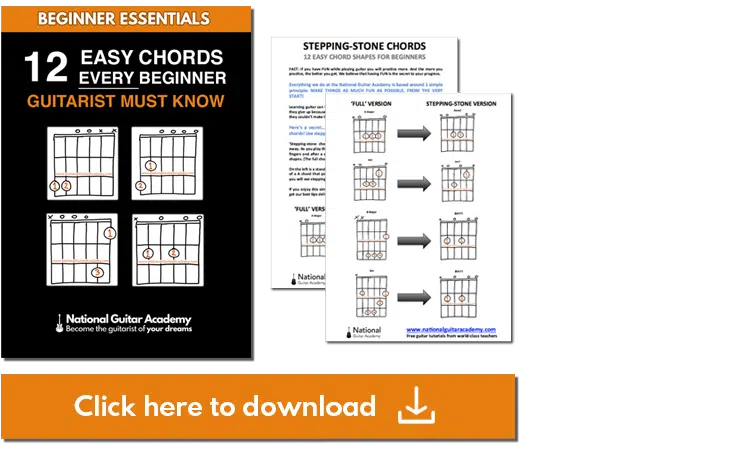
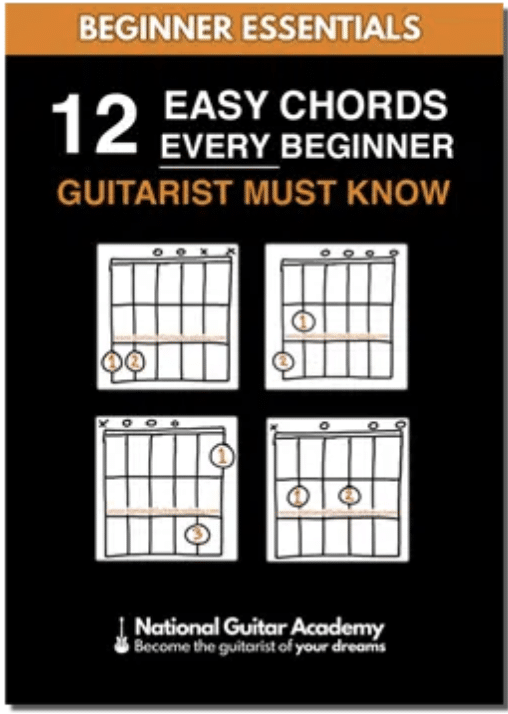
Where should we send it?
✅ Stop struggling. Start making music.
✅ Learn beginner-friendly versions of every chord.
This is our most popular guide and it will improve your chord ability quickly! 😎
Get your own personalised guitar-learning plan 🎸
Get a custom guitar-learning plan here: Click here for GuitarMetrics™
World-Class Guitar Courses 🌎
Learn from the world's best guitar educators: Click here for our guitar courses
F9 Guitar Chord – Root On E string
We have two main ways that we can play this chord in the first position.
- By playing the F9 guitar chord as a barre chord and using our pinky finger, we can preserve the brightness of the chord by playing the ninth (G) on the high E string.
- We can also play this chord with all four fingers at the first fret with open A and G strings.
- Using this chord shape will sacrifice some of the brightness in favor of an easier hand position.
Take note of the darker ‘flavour’ that the second version of the chord has, and compare it to the first as you play.
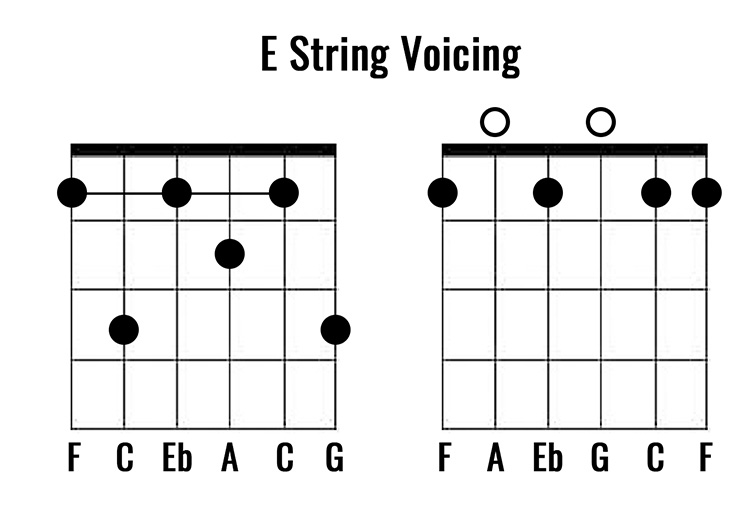
Our fingers should be arranged like so for the first example:
Low E String: Index (Barre).
- A string: Ring.
- D string: Index.
- G string: MIddle.
- B string: Index.
- High E String: Pinky.
For the second version, we can play like this:
- Low E String: Index.
- A string: Open.
- D string: Middle.
- G string: Open.
- B string: Ring.
- High E String: Pinky.

Pro Tip: Rearranging the order of the notes in a chord can produce different ‘colours’ of the same chord. The notes may be the same, however when those notes are played in different octaves than their root position form, the sound of the chord changes.
It’s important to take note of these sonic differences to better understand what we call ‘voicings.’ Voicings are the way we ‘sound out’ chords, and how we arrange the notes within those chords.
They also help us see the infinite possibilities for sound when we build different chord shapes along the fretboard.

F9 Guitar Chord – Root On A String
In order to make this version of the F9 guitar chord more accessible, we are going to remove the fifth (C) and play with only four notes.
We are able to do this because the fifth is what we can refer to as a ‘stable note’ which means that removing it will not change the overall quality of the chord you are playing. Our finger position should look like this:
- A string: Middle (F)
- D string: Index (A)
- G string: Ring (Eb)
- B string: Pinky (G)
This is a very compact version of the F9 guitar chord.
As such, it’s a great choice for the beginner guitarist who wants a large chord vocabulary but has not yet mastered barre chords.
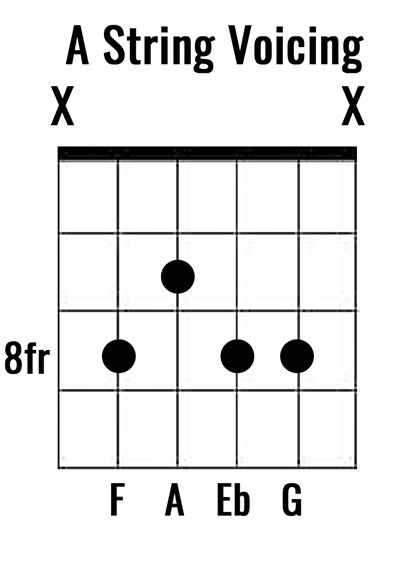
Pro Tip: This specific chord shape is often used in jazz and funk music for its stripped-back qualities.
In this genre, we often play smaller versions of common chord shapes to give the bassist room to play.
We would play this chord shape without the fifth (C) so that the bass player might play it instead.
This is a common strategy used to help better define chords being played by the whole band, rather than just one guitarist. You can hear more of this type of approach in Vulfpeck’s music.

F9 Guitar Chord – Root On D string
This is a fun shape for our fingers that will help us stretch out without the use of bar chords.
This version of the F9 guitar chord begins at the third fret on the D string (F), and once again removes the fifth (C) to make room for our fingers.
Our fingers should be positioned like this:
- D string: Middle
- G string: Index
- B string: Pinky
- E string: Ring
This chord shape may appear like a tight fit at first, but your fingers will have plenty of room to breathe.
Your fingers don’t have to remain in the middle of each fret. A bit of wiggle room can help us to sound out more complex chords.
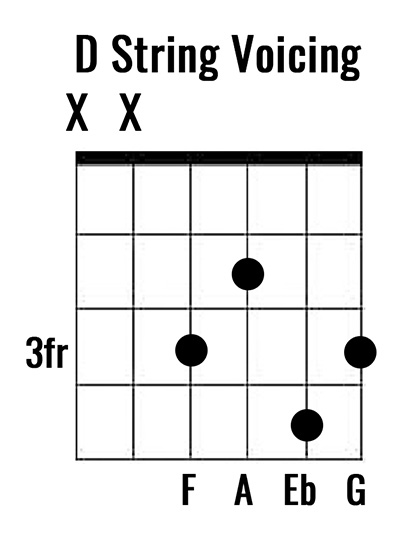
Don’t be surprised if you catch your index finger creeping toward the edge of the second fret in this shape.
Pro Tip: Sound Out Your Chords!
It’s important to check our chords to make sure we’re getting the most definition out of them as we can.
Playing chords string-by-string will help us ensure that we aren’t accidentally muting certain strings. This is called an arpeggio.
Chords always sound their best when played clearly, and the F9 guitar chord is no different.
Practice slowly and let each note ring out. Not only will this help your chord accuracy, it will also help train your ears to the sound of each chord.
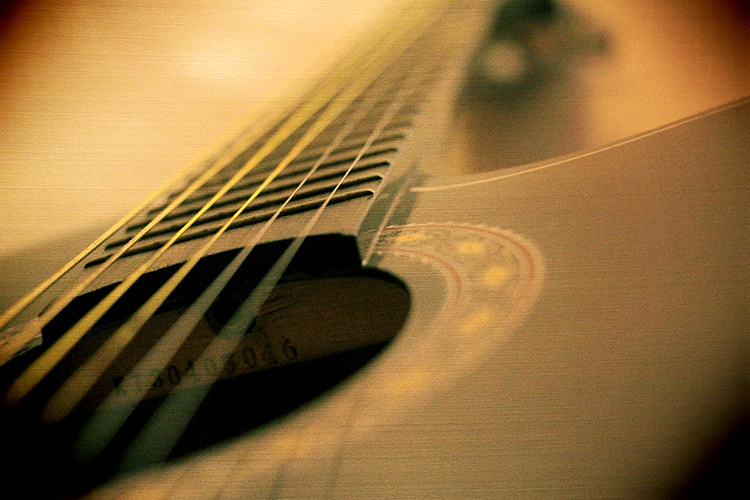
What Are ‘Inversions’?
As we discussed earlier, we can rotate the order of the notes that we play in a chord.
- This rule applies to all chords. When we rotate the notes of a chord and play on a different note we refer to this as an ‘inversion.’
- Inversions help us give new context to familiar chords, and they also help us build a better mental map of the fretboard.
- Understanding the fretboard inside and out is one of the biggest keys to playing guitar, and inversions give us a huge boost.
These ‘alternate versions’ of chords we already know help us get to know them better.
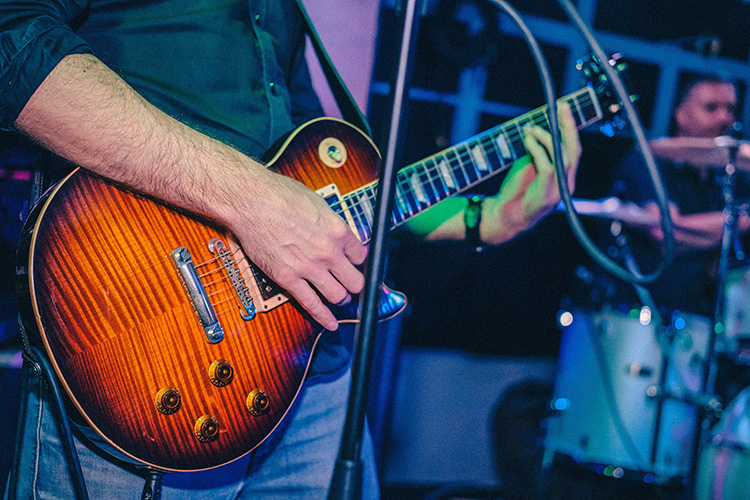
Pro Theory Tip:
Ear training is extremely important for all guitarists and musicians in general.
- Each chord type (Ninth, Major 7, Minor 7, etc) has its own distinct tone and ‘colour’, and getting to know those sounds will help us identify them.
- In order to develop our ears well, we should aim to be able to hear the colour of a chord, no matter the order of the notes.
Take the time to sing the notes as you play them and your ears will thank you.
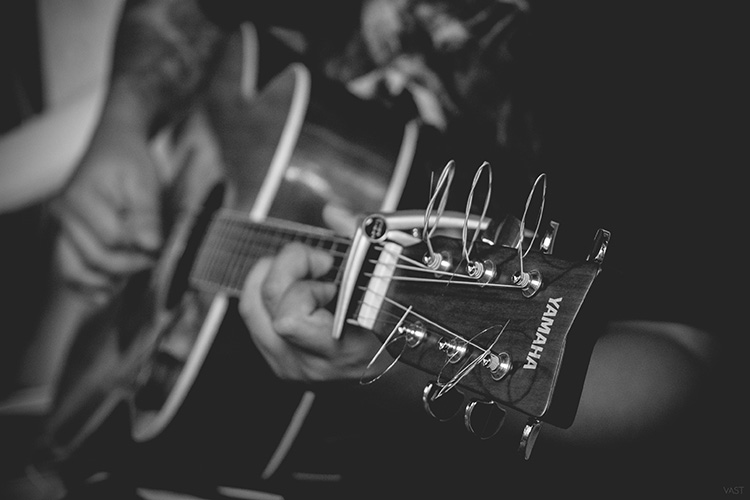
What Chords Sound Good With The F9 Guitar Chord?
We can’t learn a new chord without learning what it works with, so we’ve included a few chord progressions for you below to play.
- If you’re just starting out, you don’t have to worry about timing or strumming right away.
- Strum through each chord and get a feel for how they sound when played in a sequence.
The point of this exercise is to learn what sounds good, so there’s no need to stress over technique.
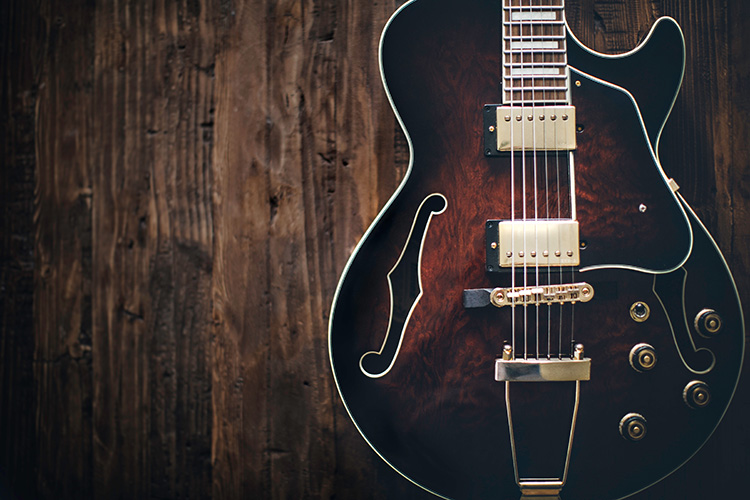
Music is a lot like cooking. We need to experiment with different flavours together to figure out what tastes right.
- You wouldn’t make a meal using only paprika. You would pair it with other spices to bring out the flavour you desire.
- One of the most important things we can do is to continue to experiment with different chords as much as possible.
Chords are what make a song.
Scales, solos, drum fills and vocals all come later, but a song has to begin with a chordal structure.
Try the F9 guitar chord with some of the chord progressions we have listed below and get an idea of what your ear likes to hear.

- F9 – Bb Power Chord (1st Fret A string) – C Power Chord (3rd Fret A string)
This is what we refer to as an “F Blues Progression”
- F9 – C9 (For this progression, play the A string version of the F9 guitar chord, and then move it to the third fret. You can rock back and forth between these two chords for a funky groove)
- F9 – C Minor – G Minor 7
If you don’t know how to play any of the chords above, check out this lesson: Guitar Chords: The Ultimate Guide
Pro Tip: We can give new life to a chord progression by simply changing the way we play it.
After you’ve gotten used to playing these progressions, experiment with different strumming patterns and styles to see what context the chords sound best in.
Sometimes you can change the entire style of a song by simply strumming a different pattern!
Download our lead guitar cheat-sheet to make things easier
It's hard to understand which scales work with which keys.
So we created a cheat-sheet! A key and scale-finder that you can use again and again.
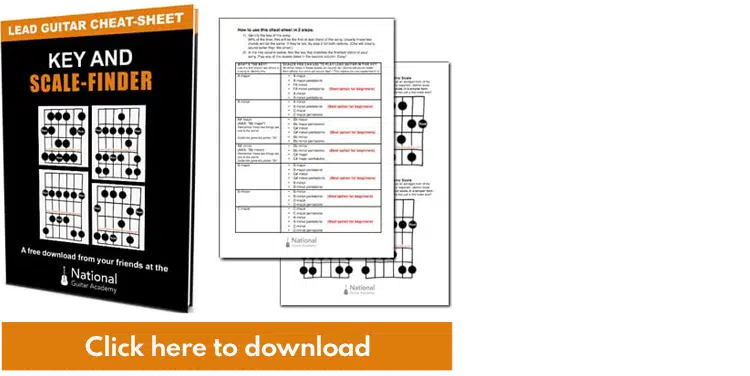
Get your personalised guitar-learning plan 🎸
Get a custom guitar-learning plan here: Click here for GuitarMetrics™
World-Class Guitar Courses 🌎
Learn from the world's best guitar educators: Click here for our guitar courses
F9 Guitar Chord Inversions
Due to the fact that this chord has five unique notes, there are four basic ways that we can invert it after we have learned the standard positions listed above.
As discussed, our notes are F, A, C, Eb, and G. This means that we can play a version of the F9 guitar chord that pivots on each of these other four notes.
Some of these chords may look like a stretch at first glance, but they can also be played in pieces to help our hands get used to the different positions.
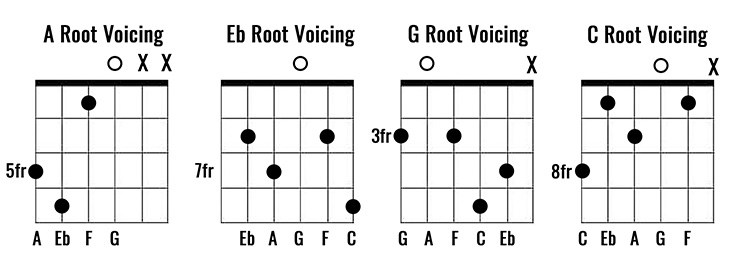
Pay close attention to the use of open strings, as the A and G notes are available in the open position.
Not only does using open strings help us minimize stress on our hands when playing complex chords, but these strings can help to ‘warm up’ chords that are played in higher octaves.
Pro Tip: Breaking chords in half is a great way for the beginner guitarist to wrap their hands (and head) around new chords.
If you see a chord that looks difficult to play, start by only playing either the three bass strings or the three treble strings of the chord.

Begin with three strings, and then add in the remainder of the chord one string at a time.
Our fingers need time and practice in order to adapt to playing guitar, so don’t rush the process of learning new chord shapes.
Challenge Yourself: Have a look at the fretboard below and find as many positions to play the F9 guitar chord in as you can.
- Keep in mind that you don’t have to play all five notes in the chord.
- This chord can be stripped back to just the notes F, G, A and Eb to be played in a condensed format.
- If you keep a practice journal, keep track of how many versions of the F9 guitar chord you have found and what their positions are.
A great book to explore chord inversions is Ted Greene’s Chord Chemistry, you can check that out here.
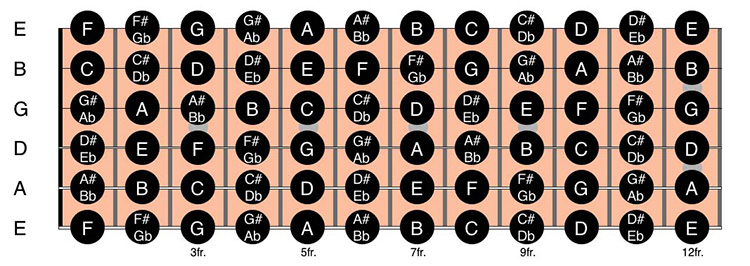
Pro Tip: Remember that any chord that doesn’t use open strings is considered a movable chord.
This means that these chord shapes can be moved into other keys simply by shifting the frets we play them on. If you want to make the F9 guitar chord a G9 instead, move the shape up two frets!
Where Do I Go From Here?
Not done honing your skills? Good. We recommend:
- Try writing a song using the F9 guitar chord.
- Practice this chord in as many positions as possible.
- Write out the chord in tablature or notation to help memorize it.
- Use this chord during a jam session.
- Try this chord in different fret positions to learn new chords.
Recommended Resources
If you loved this lesson on the F9 guitar chord, check out some of our other chord lessons below:
- Bm7 Guitar Chord: 7 Essential Chords You Must Know
- Amaj7 Guitar Chord: 9 Essential Ways to Play This Chord
- C7 Guitar Chord
- How to Play a C Bar Chord
- Barre Chords: The Ultimate Guide
What Type of Guitarist Are You?
Take our 60-second quiz & get your results: Take The Quiz
Join the world's best online guitar school 🌎
- Get your own personalised guitar learning plan (customised just for YOU).
- World-class online guitar courses. Learn at your own pace.
- Community Campus & Learning Forum - A friendly community! Connect with our team & students. 😊
- Beginner Song library with chordsheets, tabs and tips. (Songs suitable for all levels!)
- Regular live streams, seminars and Q&A sessions - Learn from world-class guitar educators. Get all your questions answered!
Click here to learn more about National Guitar Academy membership 
Cool Guitar T-shirts 😎
Look cooler! Check out our merch: Click here to see our merch store
Want free guitar tips and video lessons delivered to your inbox?
Join over 100,000 guitar-learners and subscribe to our guitar-tips-by-email service. (It's free.)
We'll send you a series of lessons that will move you to the next level of your guitar journey.
Learn how everything fits together quickly, easily and effectively. We share ninja tips (for instant fun!) but also timeless fundamentals that will deepen your understanding.


Get our best guitar tips & videos
Popular Lessons
How To Learn Guitar: An 11-Step Programme For Beginners
How To Choose The Perfect Beginner Guitar
More Cool Guitar Stuff
Learn about National Guitar Academy: About Us
Join us on Facebook for daily guitar tips.
Listen to our Learn Guitar Podcast for rapid guitar progress.
Check out our free chord lessons.


